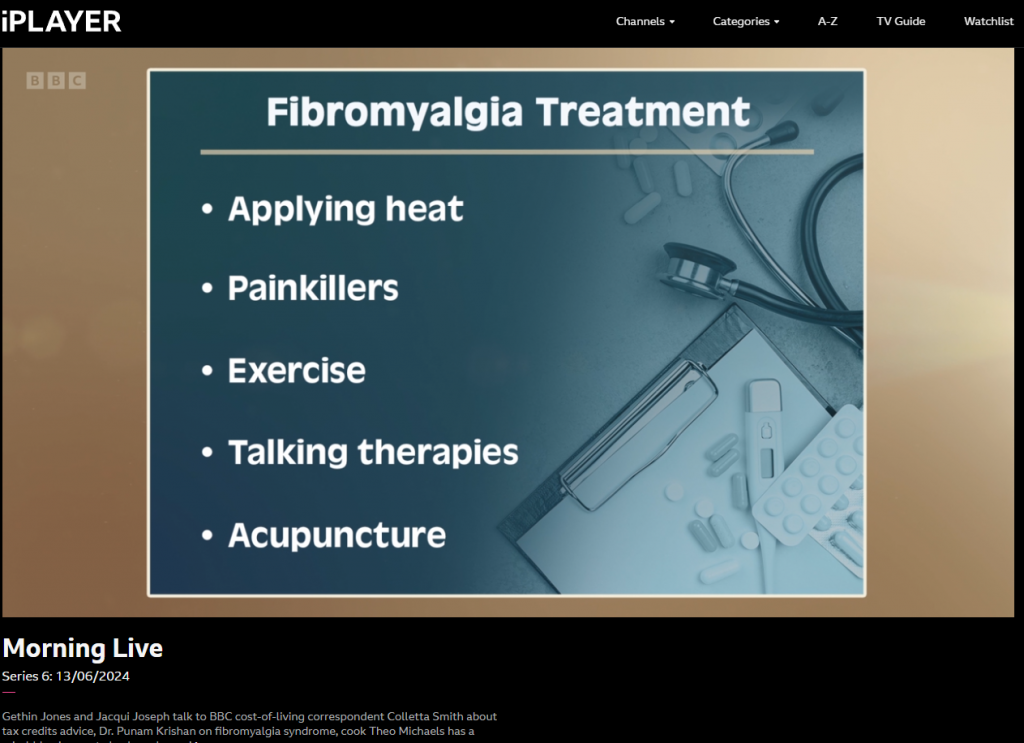Fibromyalgia – BBC Morning Live feature
🔸 ▪️ 🔸 ▪️ 🔸
✴️ Dr Punam on BBC Morning Live recommends Acupuncture and CBT as two possible approaches to help Fibromyalgia symptoms: Physiotherapy can also be beneficial
🔸 ▪️ 🔸 ▪️ 🔸
Here are the links to the original show: BBC Morning Live Series 6: 13/06/2024 (from 20 to 28 minutes, approximately). Link to the specific 8-minute segment: BBC One – Morning Live, What is fibromyalgia syndrome?
❇️❇️❇️
Understanding Fibromyalgia: A Challenging Condition
Recently, on the BBC’s Morning Live, Dr. Punam discussed fibromyalgia—a chronic condition that impacts many lives. The show’s hosts highlighted its common occurrence, and viewers flooded social media with their personal experiences. Some of the heartfelt messages included:
- Amanda – “Professionals have told me it’s in my head or it’s not a real illness! I lost my job I loved. I almost lost my home”
- Linda – “No-one believes how much pain you can be in. it can make you feel down and useless sometimes”
- Sharon – “It is an awful condition in constant pain but because it’s invisible most people don’t understand”
❇️❇️❇️
What is Fibromyalgia?

Dr. Punam explained that fibromyalgia manifests in many ways: presenting with widespread pain, extreme fatigue, and cognitive challenges (often referred to as ‘fibro fog’). Despite its prevalence—approximately one in 20 people—the underlying mechanism remains mysterious.
The condition involves altered pain processing in the spinal cord and brain. Individuals with fibromyalgia have elevated levels of certain pain-signaling chemicals, making them hypersensitive to pain. Dr. Punam emphasized the daily struggle faced by patients, saying “I have patients regularly they’re dealing with shooting pains feeling electric shocks […] imagine having to live with that every day.”
Fibromyalgia can run in families and most commonly impacts people between the ages 25 and 55, but cases have even been seen in children. Triggers may include trauma (for example a car accident), major life events (bereavement), following a viral illness, or even childbirth. However, a comprehensive understanding of why it occurs remains elusive.
❇️❇️❇️

The Stigma and Struggle
Unfortunately, those with fibromyalgia encounter stigma due to widespread ignorance. Many feel unheard, their symptoms dismissed. Dr. Punam, a GP, empathizes deeply because her own mother has battled fibromyalgia for decades. She describes her mother’s transformation from an active woman to someone crippled by fatigue and pain. Doctors often dismissed her, claiming ‘it’s all in your head.’
Dr. Punam emphasizes the impact of such dismissals: ‘When you have instances like this, the affected person feels unsupported, increasing isolation and even leading to depression.’ She highlights the lack of empathy in society toward invisible conditions, not only fibromyalgia but also chronic fatigue syndrome and autoimmune conditions. Progress is being made, but there’s still a long road ahead.
The symptoms disrupt lives—making people who once held jobs, managed households, and cared for children feel like shadows of their former selves. Diagnosis remains challenging, relying on excluding other possible causes, taking a detailed history, clinical exams, and negative test results.
❇️❇️❇️
Understanding Fibromyalgia Symptoms
The main symptoms as outlined by Dr Punam are:
- ❇️ Pain sensitivity
- ❇️ Muscle Stiffness
- ❇️ Fatigue
- ❇️ “Fibro-Fog”
- ❇️ Irritable bowel syndrome
❇️❇️❇️
▪️ Pain Sensitivity and Muscle Stiffness:
Fibromyalgia isn’t localised pain; it can affect any part of the body: Individuals become hypersensitive to even the lightest touch.
▪️ Fatigue:
“This is like waking up after hours of sleep and still feeling exhausted” says Dr Punam, and overexertion exacerbates the draining effect. This is not a generalised tiredness, it’s a depletion of energy and extreme fatigue.
▪️ “Fibro-Fog”:
- This cognitive challenge affects memory and concentration.
- In the workplace, lack of support can make it particularly difficult.
▪️ Gut Issues:
Irritable bowel syndrome (IBS) is common in fibromyalgia.
In addition to the above, restless leg syndrome and headaches may also occur.
❇️❇️❇️

Managing Fibromyalgia: Strategies and Support
According to Dr Punam, while there’s no cure, several approaches can alleviate symptoms and flare-ups:
▪️ Heat:
Heat helps with stiff joints: Try warm baths, hot water bottles, or soaking hands and feet in warm water.
▪️ Pain Relief:
Painkillers, both over-the-counter and prescription, can provide relief.
▪️ Exercise:
Proceed with caution; work within your abilities. Exercise benefits mood, releases endorphins, and improves symptoms. Consult your GP for a referral to specialised exercise guidance from a physiotherapist.
▪️ Talking Therapies:
Cognitive-behavioural therapy (CBT) helps manage thought processes, and addresses issues arising from flare-ups
▪️ Complementary and Integrated Approaches:
Acupuncture has shown promise. Yoga and Tai Chi can be beneficial
▪️ Individualized Management:
What works varies from person to person. Support from healthcare professionals, family, friends, and colleagues is essential
▪️ Antidepressants:
Beyond mood improvement, certain types can manage pain and enhance sleep quality
Remember, you’re not alone in this journey. Seek support and tailor your management plan to your unique needs.
❇️❇️❇️
Who Can Help? Our Practitioners and Therapies:
- ❇️ Acupuncture
- ❇️ CBT
- ❇️ Physiotherapy
❇️❇️❇️

Acupuncture with Shaftesbury Clinic
✴️ Acupuncture can be a part of your approach to coping with the symptoms of fibromyalgia, and it is always good to have an overall approach that takes into account your individual needs and symptoms.
✴️ You should always go in the first instance to your GP or pain consultant, but the acupuncturists at Shaftesbury Clinic are very happy to liaise with them about your care, and we often receive referrals from medical colleagues for chronic pain.
✴️ Adding to the above, where Dr Punam mentioned studies for acupuncture, Shaftesbury Clinic has a dedicated page for information and research: Shaftesburyclinic.com Fibromyalgia: Condition Resources which may be of interest.
Also good to note, is that the NHS advisory panel, NICE (National Institute for Health and Care Excellence), have recommended acupuncture for chronic pain, Shaftesburyclinic.com: acupuncture and chronic primary pain – the new nice draft guidelines
❇️❇️❇️

CBT with qualified, experienced professionals at Bedford Consulting Rooms
Cognitive Behavioural Therapy (CBT) can be a valuable part of managing fibromyalgia. It’s a psychological treatment that focuses on changing thought patterns and behaviours that are not helpful. It can help with:
✴️ Managing Pain- CBT helps individuals understand and change the way they perceive pain, which can alter their response to it. For instance, it can help reduce “catastrophizing,” which is when someone believes their situation is worse than it actually is
✴️ Improving Daily Function – By addressing negative thought patterns, CBT can lead to behaviours that improve daily functioning and exercise tolerance
✴️ Enhancing Sleep Quality – CBT can improve sleep habits, which is particularly beneficial since poor sleep can exacerbate fibromyalgia symptoms
✴️ Reducing Emotional Distress – It can help manage symptoms of depression and anxiety, which are common in people with fibromyalgia
✴️ Improving Quality of Life – Overall, CBT aims to improve the quality of life by helping individuals with fibromyalgia develop coping strategies tailored to their specific needs¹.
CBT can be an effective part of a comprehensive treatment plan that may include medication, exercise, and other therapies. NICE also recommends CBT as part of an approach to managing chronic pain in its guidelines (CG193).
❇️❇️❇️

Physiotherapy – tailored exercise and approaches to symptom management
Physiotherapy may be beneficial for individuals with fibromyalgia. It can help in several ways:
✴️ Pain Reduction: Physiotherapy techniques can help alleviate the chronic pain associated with fibromyalgia
✴️ Improving Mobility and Strength: Through targeted exercises, physiotherapy can enhance stamina and muscle strength, which may be compromised due to fibromyalgia
✴️ Stress Reduction: Physiotherapy can include methods such as deep tissue massage, which not only helps with managing physical symptoms but also aids in reducing stress
✴️ Enhancing Quality of Life: By reducing pain and stiffness, and improving physical function, physiotherapy can lead to an improved overall quality of life for fibromyalgia patients
✴️ Education and Self-Management: Physiotherapists can provide education on self-management techniques, including exercise routines that patients can continue at home to maintain their well-being
✴️ It’s important to have a tailored physiotherapy program that’s designed to meet your specific needs and limitations. Consulting with a healthcare provider or a physiotherapist can give you a better understanding of how physiotherapy can fit into your overall treatment plan for fibromyalgia
❇️❇️❇️
Links
https://www.bbc.co.uk/iplayer/episode/m00202kr/morning-live-series-6-13062024



